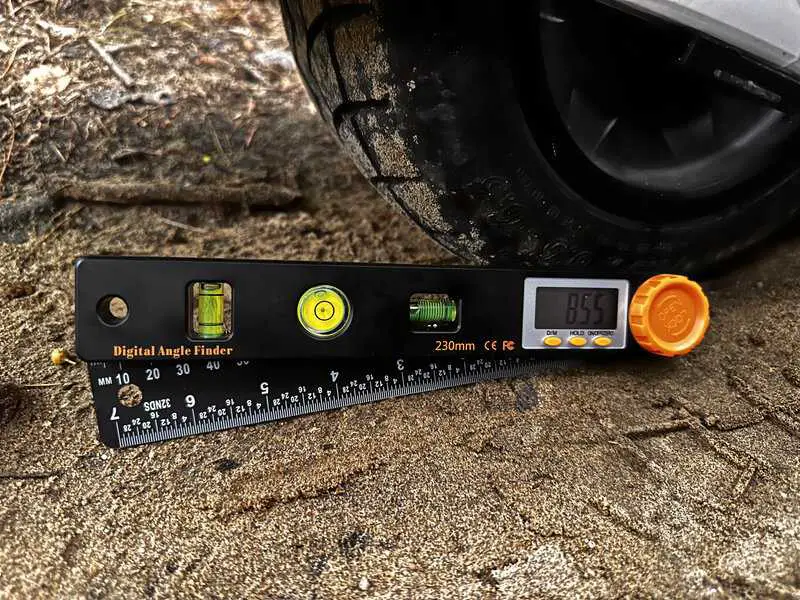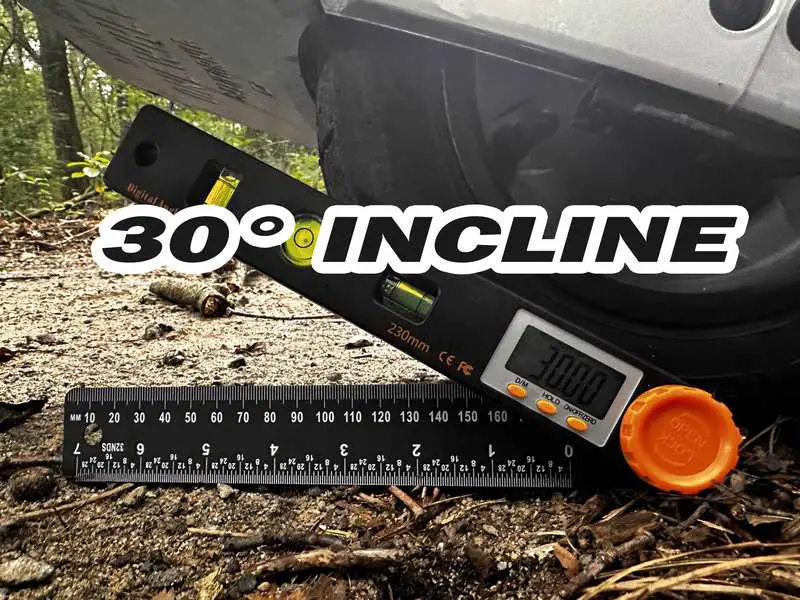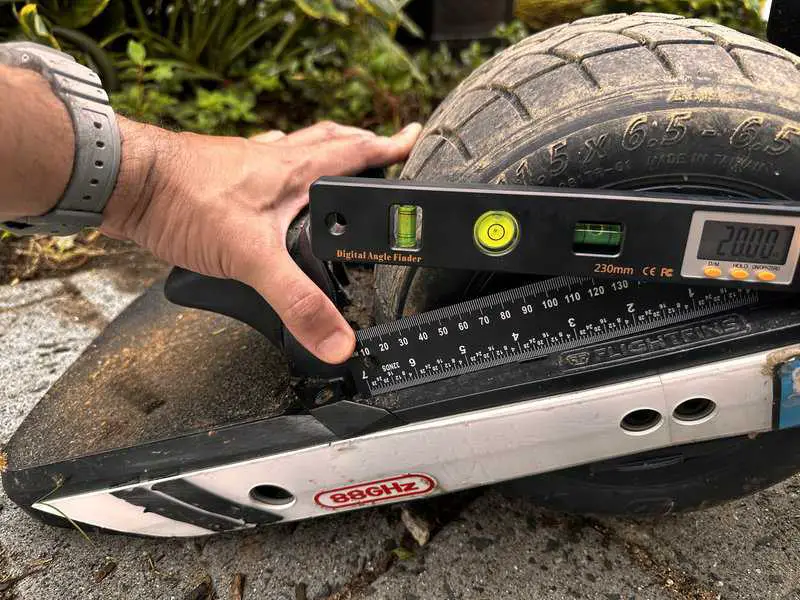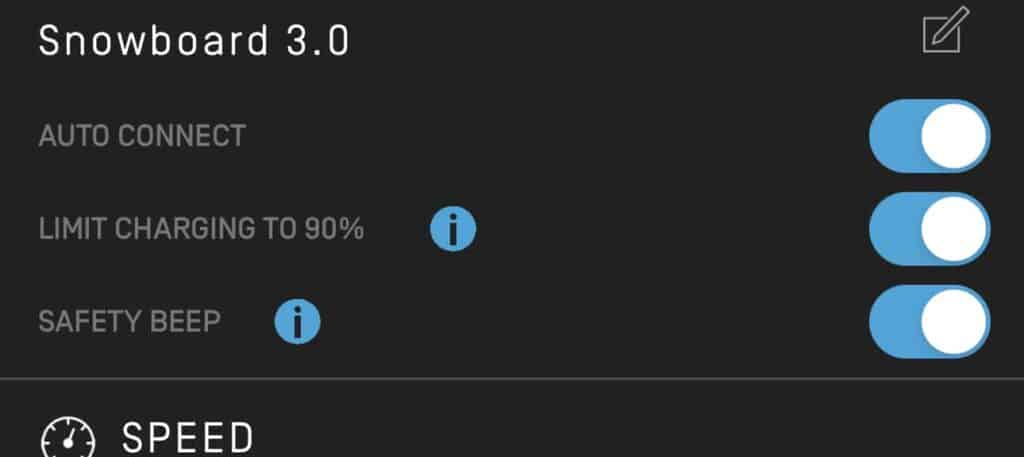The functionality of a Onewheel imposes certain restrictions on the incline grades it can handle. As the Onewheel gains speed, its front end tilts slightly downwards. When approaching a steep hill, it is crucial to ensure sufficient clearance for the nose. While the Onewheel can ascend many hills successfully, this article aims to address its limitations when dealing with slopes.
What’s the Steepest Hill a Onewheel Can Climb?
Future Motion states that the Onewheel has a max lean angle of 30 degrees before the board stops functioning. This is a horizontal angle in references to carving (sideways tilt like riding the sidewall of the tire). This does not mean you can travel up a 30° incline. 30 degrees is actually very steep. The max hill you may be able to climb is about 20° or so and there’s so many factors that go into that. Hills and inclines are rarely a straight slope. Often, there’s small divots and obstacles making the grade a little more or less challenging.

Future Motion reports the max incline (slope) a Onewheel can go up is a 15% grade. This translates to about an 8.5 degree pitch. You can calculate this by Degrees = arctan(Grade)
Degrees = arctan(0.15) ≈ 8.53 degrees
A 15% grade is approximately 8.53 degrees.
Grade is a universal measurement. A 15% grade means going up or down 15 units for every 100 units. I will personally say that you can absolutely climb a steeper incline or hill.

This image shows how exactly how steep 30 degrees is. Think about a 45° angle. A 30° is just as intense. The Onewheel is unlikely to tackle this steep of an incline as the board itself naturally will make contact with level ground at 20°. There are some strategies to help climb but 30 degrees is very steep.
In the image, you can see that a Onewheel’s nose will make contact at about 20° on level ground. This is the same pitch as when its naturally resting.
Now you can complete a rail swap and add a lift kit to your One wheel board to help with clearance but really what is going to help climb steeper hills is your approach, battery levels, PSI, overall weight and speed.

Approach the Hill Like a Tacking Sailboat Beating the Wind
You may or may not be aware that sailboats can travel against the wind. Its called “beating” or “tacking”. Tacking a sailboat against the wind is essentially zig-zagging towards the wind. This is completely analogous to Onewheels and steep hills. You have to zigzag up steeper hills. Maintaining a moderate and constant speed helps immensely with hill climbing on a Onewheel.
There’s no set angle of attack or speed because this will vary by the terrain conditions, weight of a rider, PSI, battery levels and model Onewheel. A 150lb (68 kg) street rider riding a GT Onewheel with 20PSI and 90% battery life does not need to zigzag as aggressively up a hill as a 250 lb (113 kg) XR trail rider with 16 PSI and only 30% battery would. Some terrain may be softer and will have some “give” to it when you roll on it which compromises the clearance. For this reason, it comes down to feeling.
If you’re on softer terrain, and you are a heavier rider approaching a steep hill, be mindful that the board has power limitations and if you do not maintain momentum, the board may nosedive on you. Now a 2-5 mph nosedive up a steeper hill isn’t the most dangerous situation however it’s important to feel the limitations of your Onewheel out. Practice going up a few hills and find that limit at 90%, 50% and 30% and feel that difference.
Riding a Onewheel GT Uphill – [Hill Climb Tip]
Onewheel GT has a feature many riders can’t stand and that’s the “Audible Alert”. It’s not the loudest beep in the world but if you ride with the alert on, the board will beep once it’s reached it’s power output limit. Shortly after, it will nosedive (power cut) if you do not ease off the acceleration.
Haptic Buzz is now offered if you have upgraded to the latest firmware. This is the alternative to the beep. When you reach the buzzing, you are at the limits of the torque output of the onewheel.

When you feel the beep, attempt to pull back a little off the acceleration and steepen your zigzag angle approach up the hill. You want to maintain continual momentum uphill in a fluid manner, right before the beeping sets in.
Riding a Onewheel Pint or PintX Uphill – [Tip]
The Pint and Pint X (PX) do not have audible beeping like the GT (nor does any prior model Onewheel [V1, Plus, XR]) however you can still work on the “feeling” of the Onewheel.
When climbing uphill, these models are more prone to power surging. Power surging is essentially a ‘feature’ of the Onewheel. You essentially have reached the peak output and that surging is telling you that it’s got no more power to give.
This is why I consider power surging a “feature”. Once you feel this pulsing (which is most common when climbing a hill) you need to either ease up, aggressively zig zag or get off the board and walk it out. Feeling this phenomenon that interpreting it correctly occurs will make for a more seamless ride and make you a better rider. This is your Onewheel speaking to you and its telling you it’s tired and it needs help.
Note however that if you upgraded your Pint or Pint X after the October 2023 recall, you also have Haptic Buzz. This tactile response from the motor will let you know if you hit the limit output of your board.
The Steepest Decline a Onewheel Can Handle
For all the arguments above regarding incline also factor for decline with a couple added concerns:
- Regenerative battery overcharging
- Dragging tail – unable to use the motor as a brake
Regenerative Battery Overcharge
Within the Onewheel app, the GT model allows to limit the charging to 90%. This helps with battery health and also avoids potential battery damage from overcharging.
It you start your trail ride off at the top of a hill with 100% battery, along your descent, you’re creating energy that’s being delivered into your battery through the regenerative process. Once your board exceeds 100% it will cut out so that it doesn’t damage the battery. More concerning however is that the Onewheel cuts out going down hill.
So if you are descending a steep hill, make sure you are 95% (ideally 90%) or less. If the Onewheel power cuts out on a steep hill, you only have a skidding ability to slowing you down by dragging your tail.
Tail Dragging Isn’t as Effective In Slowing Down as Regenerative Braking
All automobiles have switched to antilock braking for a reason. Skidding to a complete stop is not anywhere nearly as effective as ABS (Antilock Braking System). The same goes for Onewheel Riding. If you can not incorporate the Regenerative braking (which is similar to ABS in a way), skidding may not help especially if you’re descending a steep hill!
You can always zigzag downhill as well. Zigzagging will always lessen that angle of attack and help keep the board in control. When in doubt though, step off the board and walk down the steep grading. The board does have a maximum lean angle limit.
What is Max Lean Angle and What Does it Mean
Max lean is the maximum angle the board can operate in. It does not mean the max incline you can climb with a Onewheel. The max lean angle represents the furthest angle that the rider can lean the board before the motor no longer compensate and the device reaches its tilt limit. If you exceed this angle, the board may lose stability and could potentially lead to a fall or accident.
That being said, if you are descending a 45° hill, the motor will not keep up with the descent. The inverse is true as well. Nosediving or tail dragging is almost certain.
Never Heel-Lift Stopping on Steep Grades
If you are unfamiliar with the ways to stop a Onewheel, a heel lifting is typically the most common method. Doing this method on a hill however can be dangerous because the seconds between the time the nose or tail makes contact with the ground, the wheel can roll freely and can easily cause you to lose balance. A safer stop is to turn sideways so the board is level or make a small hop off the board (make sure you don’t watch your board go rolling down the hill either).
Never Heel-Stop Riding Uphill with Anti-Nosedive Attachments
Never heel-stop riding uphill with Fangs or Sonnywheels. Stopping when traveling uphill with wheels on the Onewheel’s nose (Fangs or Sonnywheel Sliders) will cause the board to roll out from under you as the nose typically will make contact with the ground first. Even without Fangs on the board, if you are on a steep hill and stop while going up it, the motor disengages and it can still slide out from under you.
If you want to heel stop, turn the board perpendicular to the incline so that your front or back is facing the downward part of the hill and make the stop. While not as refined, jumping off the board can be an alternative way to stopping up hill (hopefully you just don’t have to chase it downhill).
Summary
Challenge yourself to climb and descend steeper hills, just be aware of the following:
- The payload (your weight and any backpacks?)
- Battery level
- Terrain (hard or soft?)
- PSI
Once you ascend and descend hills at several battery levels, you will begin to learn when your board needs a zigzag technique. Keep trying steeper hills until you reach your comfortable limit. Also, be wary of heel-lift stopping moving up or down a hill. When you disengage the sensor with a heel-lift, the wheel is free-rolling. Even for a split second, you may have an unexpected meeting with the pavement. Challenge yourself to hill climb. Avoid carrying your board when you can and stay floating!
